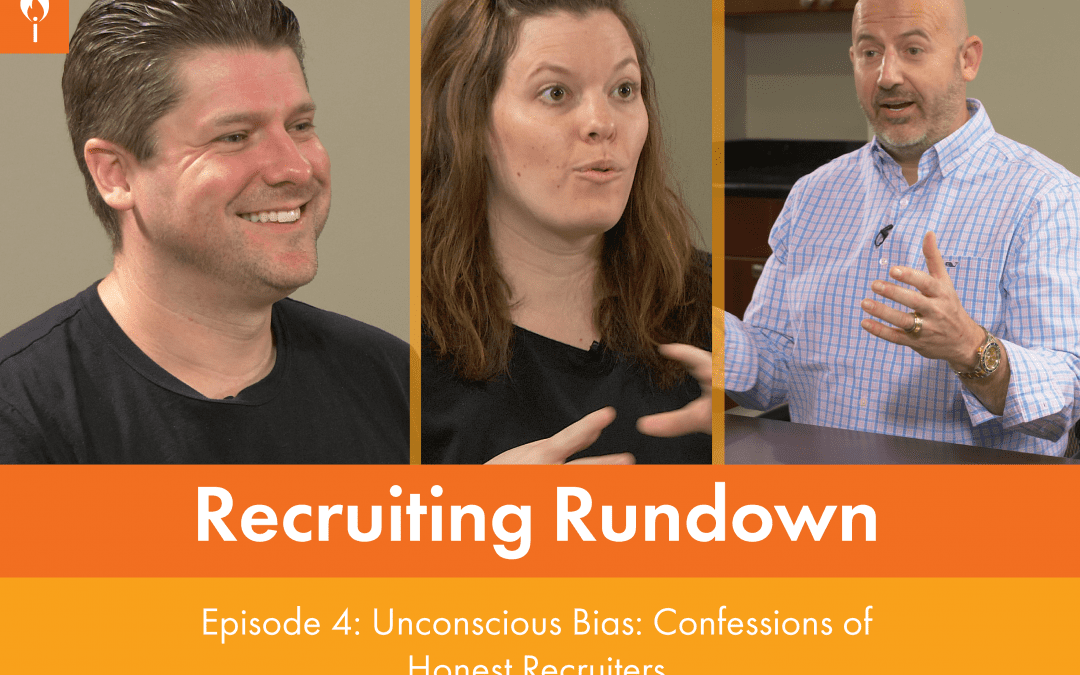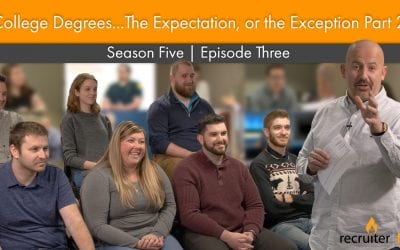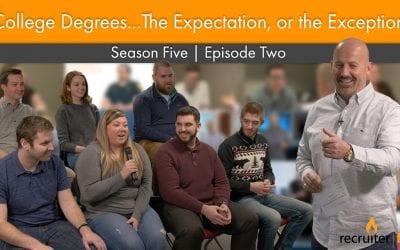
Season 3, Episode 4:
Unconscious Bias: Confessions of Honest Recruiters
When I say unconscious bias, what comes to mind?
“Scary,” says Andrew. “Obviously with today’s climate everybody wants to treat everybody equally and everyone also wants to avoid any potential landmines when they’re looking for candidates.”
Well said, Andrew.
Is unconscious bias a real thing?
Quickly, Melissa confirms: yes. It’s a real thing.
Melissa remembers specific clients who were, let’s say, a little more nitpicky with resumes than the average Joe. After going around in circles and trying to problem solve, she came up with a solution: remove names from the resumes.
Her strategy worked. “It was interesting to see the candidates that clients were originally declining for whatever reason… and they ended up choosing and moving forward with the interview and actually hiring them.”
This practice is called blind hiring and it’s becoming more common as companies work harder to fight bias decisions in the workplace. There are multiple automation software that’ll blind resumes for you, but Melissa was a trooper and took matters into her own hands.
The first thing that pops into Andrew’s mind is “people with a lot of jobs in a short amount of time.” Both clients and recruiters take one look at a resume, see short stints in different roles, and, just like that, the candidate is discredited. Their mind automatically turns negative and candidates aren’t given a fair chance. “Sometimes people have good reasons why they’ve made moves. Really, it’s drilling down and understanding why they came to a company, why they left, what they learned, and what happened next.”
What’s the first thing you look at on a LinkedIn profile?
The response was unanimous: the picture.
Host Steve Lowisz confessed to succumbing to his own unconscious bias in a recent LinkedIn search. He was sifting through profile after profile, discarding candidate after candidate.
Then, he realized he never even got past the photo. “I hate to admit this, but this is something that really happens.”
Thankfully, Steve caught himself and went back through the dismissed profiles. He had a pretty honest conversation with himself, too, asking “why did I skip this person just because the picture looked this way or I didn’t think it was professional enough?”
Have you seen that physical bias pop up, especially because of social media?
Interestingly, Andrew’s response sparked a sort of a-ha moment. “When there’s a LinkedIn profile, which is your face smiling, then there’s you with your kids, then you doing something ridiculous… obviously, it doesn’t make you look professional.”
Steve quickly pointed out, “That’s your unconscious bias!”
Melissa agreed, though. “As a recruiter, you’re looking at somebody’s picture and it’s not professional, you know your client is probably going to look at it at some point.”
In a sense, Melissa, Steve, and Andrew collectively feel trapped by another layer of unconscious bias, except it’s not their own—it’s the clients’.
Steve continues on to explain that “we’ve had clients [at Qualigence] that have said, ‘hmm, I looked at their LinkedIn profile…’ and we have to stop them because you’re bordering on legal versus illegal.”
Regardless of where the bias comes from, recruiters everywhere need to become more self-aware and make strides toward a more inclusive recruitment and hiring process.
Which brings us to our next question.
If you were to give a client or another recruiter advice on how to avoid unconscious bias, what advice would you give?
Andrew’s advice? Check your bias at the door. “If you want to succeed in this industry, at this time with unemployment being as low as it is, you have to call everyone you can. Use all of the information you have at hand and then if you’re not sure on somebody, try to drill down a little bit more before you make a decision.”
Melissa advises recruiters and clients alike to make a conscious effort to ignore the easy stuff, like looking at LinkedIn profile pictures or names. Pay attention to experience and, before you make that decision about why candidates would or wouldn’t be a good fit, make sure you know all the “why’s.” Ask the right questions and do what you’re supposed to do as a recruiter.
Steve agrees but closes with this important note. “It’s one of those things that, I’m not sure you can completely avoid or that we ever will because we’re human beings. Certain things affect all of us a little bit differently.”
What do you think? Will we ever truly be able to leave our unconscious bias behind during recruitment and hiring? Let us know your thoughts!
About Recruiter Fuel
Recruiter Fuel is a weekly video series dedicated to all-things recruiting and talent acquisition. Learn More our mission and how you can submit a topic, be featured in an episode, or nominate an expert to guest star on an upcoming episode.
Visit the Recruiter Fuel series directory for more content.





